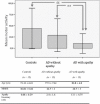REVIEW: Apathy diagnosis, assessment, and treatment in Alzheimer's disease
- PMID: 20345973
- PMCID: PMC6493869
- DOI: 10.1111/j.1755-5949.2009.00132.x
REVIEW: Apathy diagnosis, assessment, and treatment in Alzheimer's disease
Abstract
Apathy is defined as a disorder of motivation. There is wide acknowledgement that apathy is an important behavioral syndrome in Alzheimer's disease and in various neuropsychiatric disorders. In light of recent research and the renewed interest in the correlates and impacts of apathy and in its treatments, it is important to develop criteria for apathy that will be widely accepted, have clear operational steps, and be easy to apply in clinical practice and in research settings. Meeting these needs was the focus for a task force that included members of the European Psychiatric Association, the European Alzheimer's Disease Consortium and experts from Europe, Australia and North America.
© 2010 Blackwell Publishing Ltd.
Conflict of interest statement
The authors have no conflict of interest.
Figures


Similar articles
-
Proposed diagnostic criteria for apathy in Alzheimer's disease and other neuropsychiatric disorders.Eur Psychiatry. 2009 Mar;24(2):98-104. doi: 10.1016/j.eurpsy.2008.09.001. Epub 2009 Feb 7. Eur Psychiatry. 2009. PMID: 19201579
-
Treating apathy in Alzheimer's disease.Dement Geriatr Cogn Disord. 2004;17(1-2):91-9. doi: 10.1159/000074280. Epub 2003 Oct 15. Dement Geriatr Cogn Disord. 2004. PMID: 14564128 Review.
-
[Apathy in Alzheimer's disease].Braz J Psychiatry. 2006 Sep;28(3):238-41. doi: 10.1590/s1516-44462006000300017. Epub 2006 Aug 15. Braz J Psychiatry. 2006. PMID: 16816880 Review. Portuguese.
-
Apathy in neuropsychiatric disease: diagnosis, pathophysiology, and treatment.Neurotox Res. 2011 Feb;19(2):266-78. doi: 10.1007/s12640-010-9196-9. Epub 2010 May 15. Neurotox Res. 2011. PMID: 20473601 Review.
-
Apathy syndrome in Alzheimer's disease epidemiology: prevalence, incidence, persistence, and risk and mortality factors.J Alzheimers Dis. 2013;33(2):535-43. doi: 10.3233/JAD-2012-120913. J Alzheimers Dis. 2013. PMID: 23001707
Cited by
-
Facial expression in Alzheimer's disease: impact of cognitive deficits and neuropsychiatric symptoms.Am J Alzheimers Dis Other Demen. 2012 Mar;27(2):100-6. doi: 10.1177/1533317512440495. Am J Alzheimers Dis Other Demen. 2012. PMID: 22495337 Free PMC article.
-
Apathy and white matter integrity in Alzheimer's disease: a whole brain analysis with tract-based spatial statistics.PLoS One. 2013;8(1):e53493. doi: 10.1371/journal.pone.0053493. Epub 2013 Jan 3. PLoS One. 2013. PMID: 23301077 Free PMC article.
-
Relationship between apathy and tumor location, size, and brain edema in patients with intracranial meningioma.Neuropsychiatr Dis Treat. 2015 Jul 13;11:1685-93. doi: 10.2147/NDT.S85288. eCollection 2015. Neuropsychiatr Dis Treat. 2015. PMID: 26203250 Free PMC article.
-
"He Just Doesn't Want to Get Out of the Chair and Do It": The Impact of Apathy in People with Dementia on Their Carers.Int J Environ Res Public Health. 2021 Jun 11;18(12):6317. doi: 10.3390/ijerph18126317. Int J Environ Res Public Health. 2021. PMID: 34207955 Free PMC article.
-
Peptide YY Causes Apathy-Like Behavior via the Dopamine D2 Receptor in Repeated Water-Immersed Mice.Mol Neurobiol. 2018 Sep;55(9):7555-7566. doi: 10.1007/s12035-018-0931-1. Epub 2018 Feb 10. Mol Neurobiol. 2018. PMID: 29429048 Free PMC article.
References
-
- Robert P, Verhey F, Byrne EJ, et al Grouping for behavioral and psychological symptoms in dementia: Clinical and biological aspects. Consensus paper of the European Alzheimer Disease Consortium. Eur Psychiatry 2005;20:490–496. - PubMed
-
- Starkstein SE, Leentjens AFG. The nosological position of apathy. J Neurol Neurosurg Psychiatry 2008;79:1088–1092. - PubMed
-
- Marin RS. Apathy: A neuropsychiatric syndrome. J Neuropsychiatry Clin Neurosci 1991;3:243–254. - PubMed
-
- Marin RS. Differential diagnosis and classification of apathy. Am J Psychiatry 1990;147:22–30. - PubMed
-
- Marin RS, Fogel BS, Hawkins J, Duffy J, Krupp B. Apathy: A treatable syndrome. J Neuropsychiatry Clin Neurosci 1995;7:23–30. - PubMed
Publication types
MeSH terms
Substances
LinkOut - more resources
Full Text Sources
Medical

